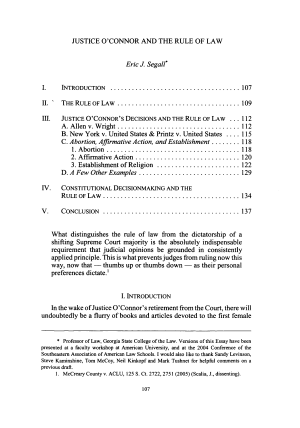Justice O'Connor and the Rule of Law
April 1, 2006

DISCLAIMER: This text has been transcribed automatically and may contain substantial inaccuracies due to the limitations of automatic transcription technology. This transcript is intended only to make the content of this document more easily discoverable and searchable. If you would like to quote the exact text of this document in any piece of work or research, please view the original using the link above and gather your quote directly from the source. The Sandra Day O'Connor Institute does not warrant, represent, or guarantee in any way that the text below is accurate.
Article Text
(Excerpt, Automatically generated)
JUSTICE O'CONNOR AND THE RULE OF LAW
Eric J. Segall*
INTRODUCTION 107
' THE RULE OF LAW 109
JUSTICE O'CONNOR'S DECISIONS AND THE RULE OF LAW 112
Allen v. Wright 112
New York v. United States & Printz v. United States 115
Abortion, Affirmative Action, and Establishment 118
Abortion 118
Affirmative Action 120
Establishment of Religion 122
A Few Other Examples 129
N. CONSTITUTIONAL DECISIONMAKING AND THE
RULE OF LAW 134
CONCLUSION 137
What distinguishes the rule of law from the dictatorship of a shifting Supreme Court majority is the absolutely indispensable requirement that judicial opinions be grounded in consistently applied principle. This is what prevents judges from ruling now this way, now that - thumbs up or thumbs down - as their personal preferences dictate.1
INTRODUCTION
In the wake of Justice O'Connor's retirement from the Court, there will undoubtedly be a flurry of books and articles devoted to the first female
- Professor of Law, Georgia State College of the Law. Versions of this Essay have been presented at a faculty workshop at American University, and at the 2004 Conference of the Southeastern Association of American Law Schools. I would also like to thank Sandy Levinson, Steve Kaminshine, Tom McCoy, Neil Kinkopf and Mark Tushnet for helpful comments on a previous draft.
McCreary County v. ACLU, 125 S. Ct. 2722, 275 l (2005) (Scalia, J., dissenting).
107
108 UNIVERSITY OF FLORIDA JOURNAL OF LAW & PUBLIC POLICY [Vol. 17
Justice and her many
